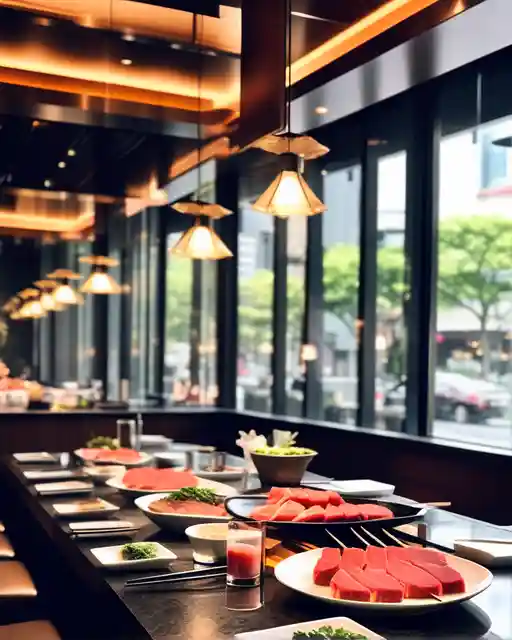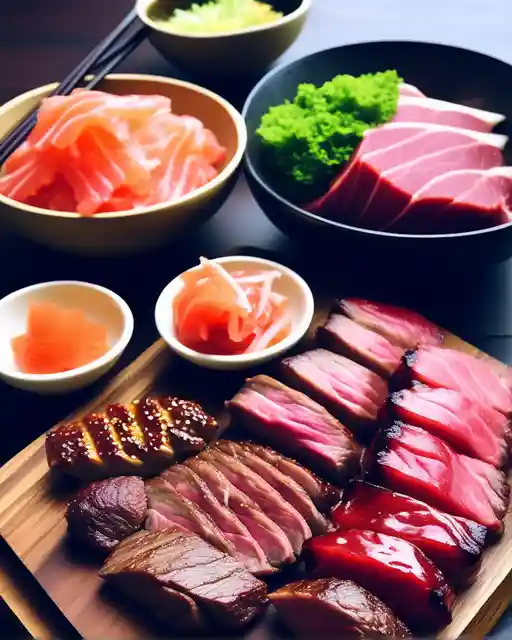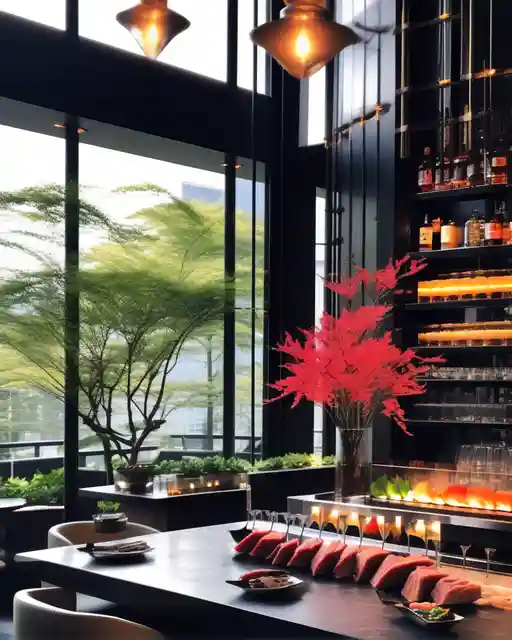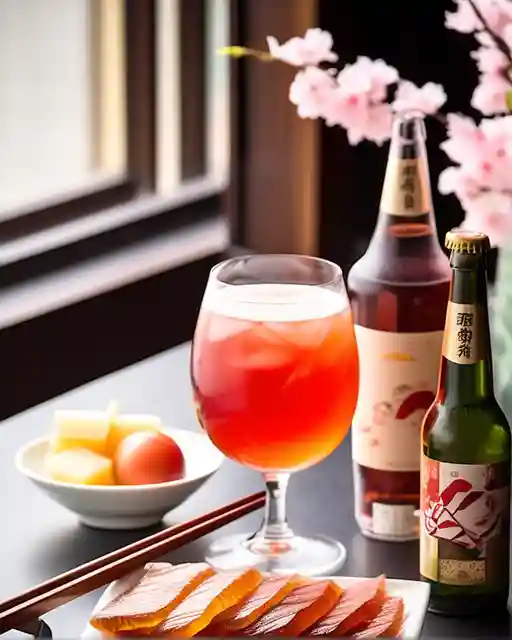Yakiniku Restaurant | Lets You Play Chef at Fun DIY Grills
Updated: 16 Jul 2023
174

The smell of sizzling meat fills the air as you walk into a yakiniku restaurant. This Japanese style of barbecue features tender, flavorful meats like wagyu beef grilled right at your table.
At a yakiniku restaurant, platters of thin-sliced beef, pork, chicken, and veggies arrive raw and ready for you to cook just how you like on a smokeless grill built right into your table.
Yakiniku brings family-style dining to the next level, cramming around a small table and grilling premium cuts of meat just how you like it.
Table of Contents
What is Yakiniku?
Yakiniku gives “grill it yourself” a Japanese twist with sizzling plates of raw, thin-sliced wagyu beef, juicy pork belly, and plump chicken arriving at tables equipped with smokeless kondo grills. This interactive dining sees groups cooking their tender proteins and veggies, dipping them in tare sauce, and bonding over the tabletop feast.
The Origins of Yakiniku
Yakiniku originated after World War II when Japanese Americans returned home craving the Korean barbecue they had eaten abroad. Restaurateurs adapted the Korean style of grilling meats by cutting ingredients thinner and serving them with dipping sauces to appeal to Japanese tastes.
Types of Yakiniku Restaurants
1. High-End vs Budget Yakiniku

- High-end yakiniku serves expensive Japanese wagyu beef and craft cocktails in upscale settings, while budget spots offer more affordable meat cuts in casual spaces.
2. Japanese vs Korean Yakiniku

- Japanese yakiniku focuses on premium wagyu with dipping sauces, while Korean-style spots serve marinated meats like bulgogi and feature kimchi and spam wraps.
3. All-You-Can-Eat Yakiniku

- Order unlimited proteins and sides for a fixed price; cook and refill your plate with meats, veggies, and noodles from large, shared platters.
Popular Yakiniku Dishes
1. Wagyu Beef
Wagyu beef is the holy grail of meats at a yakiniku restaurant. These Japanese cattle are specially bred and raised to produce beautifully marbled, tender, rich-tasting beef cuts perfect for the grill. Thin slices of wagyu like ribeye and striploin cook quickly over the fiery koro grill.
Here are 6 types of best Beef
- Jambo Hanare

Trendsetting Tokyo yakiniku with stylish interiors, taking wagyu beef to new heights with cuts like Olive Wagyu sirloin paired with fruit-infused spirits.
- Nakahara
Michelin-starred Osaka spot focussing on premium Japanese beef alongside premium service in an urban, modern setting befitting the upscale cuisine.
- Yakiniku Like
Budget-friendly chain offering delicious yakiniku dining and quality wagyu at inexpensive all-you-can-eat prices, perfect for big appetites.
- Namaiki
Hip Brooklyn yakiniku joint mashing up Korean and Japanese grilling traditions into creative dishes like bulgogi tacos and wagyu banh mi sandwiches.
- Yoroniku
LA’s first yakiniku restaurant specializing in high-end Japanese wagyu paired with wine in a sleek and modern dining room with expert service.
- Yakiniku Ushigoro
Tokyo veteran since 1950 grilling classic cuts of heavily marbled Japanese black cattle on binchotan charcoal for full-on old school yakiniku flavor.
2. Pork Belly (Butabara)
Slabs of fatty, yet wonderfully flavorful pork belly get grilled until crispy and caramelized. The marbling keeps this cut moist with a delicate sweetness that pairs nicely with citrus ponzu sauce for dipping. Crisp yet tender pork belly is a yakiniku menu essential.
2. Chicken (Negima)
Negima are tender strips of chicken thigh with bits of scallion sandwiched in between, grilled until juicy and chars start to appear. Quick cooking Negima picks up nice smokey notes from the special bincho charcoal heat source that enhances the natural flavors.
3. Vegetables
A variety of vegetables act as palate cleansers between meat courses at a yakiniku meal. Onions, mushrooms, peppers, and squash get a quick grilling to bring out new depths of sweetness and savoriness beautifully complemented by garlic or sesame-based tare dipping sauce.
4. Dipping Sauces
Yakiniku dining lacks flavorful dipping sauces like sweet and salty tare, aromatic sesame, and bright citrus ponzu to dress the grilled meats and vegetables. These sauces let you control the flavor profiles with each piece.
Yakiniku Dining Experience
1. Cook Meat and Veggies at Your Table
Tables at yakiniku restaurants have personal smokeless koro grills built right into them, fueled by special bingo charcoal. Plates of various thin-sliced raw proteins like wagyu beef and pork belly arrive ready for you to cook yourself on the small grill to your preferred doneness levels.
2. Social, Interactive Dining
The hands-on cooking brings people together, making yakiniku a highly social and interactive dining experience. Friends and family sit crammed around the six-person tables, chatting while tending to sizzling skewers and flipping fatty Wagyu cuts, enhancing the whole experience.
3. Order Different Cuts of Wagyu
Yakiniku menus offer so many premium Japanese wagyu beef options to indulge in. From richly marbled ribeye, and tender sirloin, to thinly sliced beef tongue – part of the fun is sampling various exclusive wagyu cuts seared perfectly on the konro grill.
4. Dip in Flavorful Sauces
Half the flavor at a yakiniku meal comes from the array of homemade sauces for dipping the blistering hot proteins and vegetables right off the grill. Tangy tare with citrus and soy or nutty, aromatic sesame dressings add even more complexity.
Popular Sides and Drinks
1. Beer, Sake, Plum Wine

Crisp, light beer is the most popular drink pairing for yakiniku’s rich meats. Other great Japanese drink pairings include warming sake, sweet and tart plum wine, whisky highballs, and shochu mixed with water or soda – all of which stand up to the smoky, umami flavors.
2. Rice and Kimchi
Steamed white rice and fiery kimchi balance the intense proteins at a yakiniku feast. Rice soaks up the sweet juices while the funk and spice of kimchi cuts through the smoke and fat for the perfect palate cleanser between meat courses.
3. Miso Soup and Salad
Traditional miso soup with soft tofu and wakame seaweed brings a light, comforting start to a yakiniku dinner. Crisp house salads tossed in tangy ginger dressing also serve as refreshing breaks between all the sizzling, smoky meat straight from the grill to your plate.
Ambiance and Decor
1. Dark Wood Interiors
The dark wood-paneled walls, tables, and booth seating at most yakiniku restaurants create an intimate yet upscale ambiance. Bamboo dividers offer a subtle distinction between dining areas while warm overhead lighting sets an inviting mood.
2. Low Tables and Built-In Grills
The signature smokeless konro tabletop grills are sunken into low wooden dining tables that have cushions for kneeling on the floor in typical Japanese style. Some modern locales may have regular-height seating as well.
3. Large Exhausts
Powerful exhaust ventilation hangs over each grill to prevent smoke and smells from filling the dining rooms. Without these systems continually sucking up air, the savory smells would overwhelm due to proteins and fats hitting the hot coals.
4. Open Kitchens
Many yakiniku eateries have open kitchens allowing diners to see ingredients prepped or glimpse chefs assembling plates behind counters adding to the interactive dining experience. Customers can view raw meat selections before they arrive at their tables for grilling too.
Final Thoughts
Yakiniku takes barbecue to the next level with plates of raw wagyu beef and pork belly arriving at smokeless tableside konro grills waiting for you to work your magic.
From the interactive custom cooking to the exquisite marbled wagyu, yakiniku restaurants deliver a uniquely unforgettable and experience not found on any American menu. Go get your grill on and savor sublimely seared meat at this one-of-a-kind cuisine!
FAQs
What kind of restaurant is yakiniku?
Yakiniku restaurants are Japanese barbeque eateries where you cook thinly sliced meat, seafood, and vegetables on a smokeless grill built right into your table.
What is the meaning of yakiniku?
The word “yakiniku” translates to grilled (yaki) meat (niku) in Japanese. It refers to a style of casual, do-it-yourself dining where ingredients are grilled at your table.
What type of food is yakiniku?
Yakiniku serves Japanese-style barbecued dishes including wagyu beef, pork belly, chicken, and vegetables that you cook yourself on tabletop grills.
How much does yakiniku cost?
Yakiniku meal costs range widely from budget all-you-can-eat starting around $25 per person to luxury wagyu experiences averaging $100 or more per person.
Can I eat yakiniku alone?
While yakiniku draws more social diners, solo customers can still indulge in these grill-it-yourself feasts alone and may even chat with fellow diners.
Is yakiniku only beef?
No – while wagyu beef is popular, yakiniku also features other proteins like pork, chicken, shrimp, and vegetables as well as Korean staples like kimchi.
Please Write Your Comments